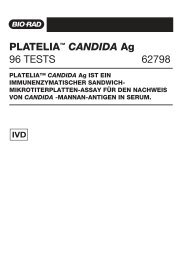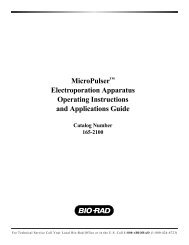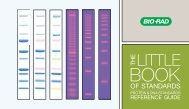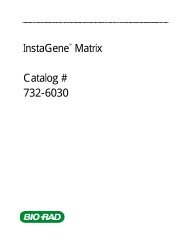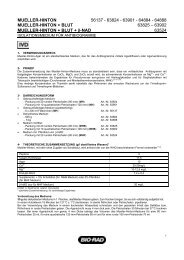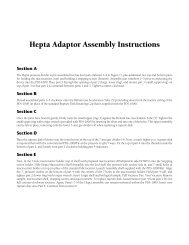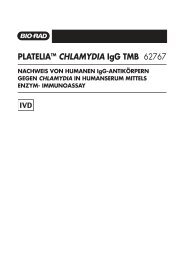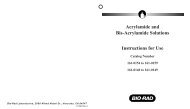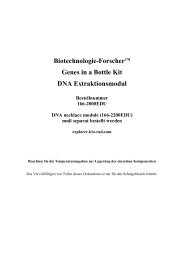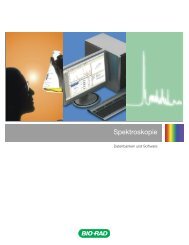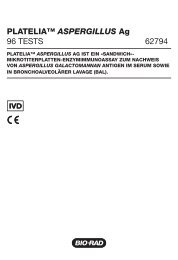Protein Expression and Purification Series - Bio-Rad
Protein Expression and Purification Series - Bio-Rad
Protein Expression and Purification Series - Bio-Rad
Create successful ePaper yourself
Turn your PDF publications into a flip-book with our unique Google optimized e-Paper software.
<strong>Protein</strong> <strong>Expression</strong> <strong>and</strong> <strong>Purification</strong> <strong>Series</strong><br />
Removing Imidazole (Desalting) from the Purified GST-DHFR-<br />
His <strong>and</strong> Preparing Samples for SDS-PAGE Analysis<br />
Student Workstations<br />
Each student team requires the following items to desalt three of their fractions in which they think their<br />
GST-DHFR-His samples reside <strong>and</strong> to prepare SDS-PAGE samples:<br />
Material Needed for Each Workstation Quantity<br />
Chromatogram from GST-DHFR-His purification 1<br />
Fractions from GST-DHFR-His purification varies<br />
Desalting column 3<br />
Screwcap microcentrifuge tubes, 1.5 ml 6<br />
Laemmli buffer (left over from previous activity) 1 ml<br />
Microcentrifuge tubes, 2 ml 6–12<br />
20–200 µl adjustable-volume micropipet <strong>and</strong> tips 1<br />
Marking pen 1<br />
Common Workstation Quantity<br />
Microcentrifuge with variable speed setting >16,000 x g 1<br />
Dry bath or water bath set at 95°C 1<br />
At this point, there might be several fractions that contain the eluted GST-DHFR-His protein. It is important<br />
to determine which fractions the purified GST-DHFR-His is present in <strong>and</strong> which fraction(s) have the highest<br />
concentration of GST-DHFR-His. It might be assumed that the fractions marked by the DuoFlow software<br />
on the chromatogram where the peak eluted are the specific fraction tubes where the protein can be<br />
found. However, it should be noted, that there is a time delay from when the absorbance of the fraction<br />
is measured on the UV detector to when it flows through the tubing past the conductivity meter <strong>and</strong> out<br />
into the fraction collector. This is called a delay time (or volume). For example, in Figure 8.29, according<br />
to the chromatogram, the protein should have eluted in fractions 7–8. Again, this would be assuming that<br />
there is no delay between when the protein is detected in the UV detector <strong>and</strong> when it drops into a fraction<br />
collector tube.<br />
Figure 8.29. Chromatogram of a run. If there was no delay volume between the UV detector <strong>and</strong> fraction collector, the GST-DHFR-<br />
His would be assumed to be in fractions 7, 8, <strong>and</strong> 9. However, there is a finite delay time between detection <strong>and</strong> collecting that can<br />
be calculated or measured.<br />
The delay time (volume) can be calculated by measuring the length of tubing present between the detector<br />
<strong>and</strong> the fraction collector as well as knowing the volume of all fittings in between the UV monitor <strong>and</strong> the<br />
fraction collector. It can also be measured experimentally ahead of time by attaching a syringe to the fitting<br />
Chapter 8: <strong>Purification</strong> Protocol for <strong>Bio</strong>Logic DuoFlow System<br />
187<br />
CHAPTER 8<br />
BIOLOGIC DUOFLOW<br />
PROTOCOL




